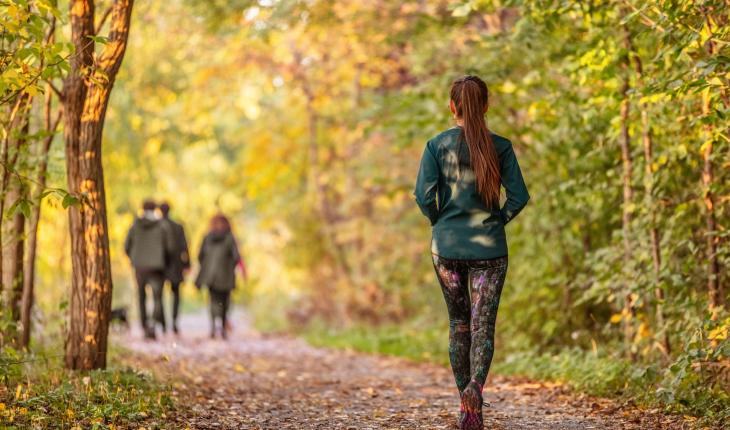Healthy Brains
Articles focusing on various aspects of healthy brains
Reading time: about 6 minutes
Walking has been shown to be one of the most effective ways to get exercise and when we look at the neurological impacts, they are pretty impressive. Combine this with exposure to nature and we have an even more potent tool for boosting health.

When I speak at public events there are always guaranteed to be two types of questions that I get. One will be on certain mental disorders, normally from a member of the audience who has a family member with a specific disorder. Two will be something to do with healthy brains. This second one may be guided by current trends which may vary from eating nuts, omega-3 fats, meditation, or any number of other trends or recent news reports. Many of these trends or news stories are based on research and therefore have some element of truth in them. But as many of you know I always like to take a step back and look at the big picture – I think of what the actual biggest impact is on an individual and an individual’s brain.
One of the most striking things is that often simple things have large impacts. Apologies this is sometimes a bit “boring”, no hype here. And the simplest of them all is probably walking. This is probably nothing new to many of you readers, but let’s review the research anyhow just so you understand how powerful and how impactful this is, and the dramatic benefits for your brain. I also claim that by taking a few adjustments and combining a couple of other elements, such as nature, we can boost the positive benefits even more and this has well documented and powerful impacts on your brain.
Shane O’Mara is an Irish neuroscientist who has written book on the power of walking “In Praise of Walking”. Many of the benefits are the benefits we can see from physical exercise in general. The most dramatic of which is an increase in something known as Brain-Derived Neurotrophic Factor (BDNF). It is a mouthful to say but when neuroscientists talk about BDNF it means brain growth. BDNF is the brain’s growth hormone so when more of this is released it means bits of your brain are growing. Similarly, neurogenesis in the hippocampus is shown to be promoted by exercise. Why is the hippocampus important – well this is often considered our memory centre – or at least a part of the brain that is critically involved in memory consolidation. But more than that the hippocampus and closely related regions are involved in spatial orientation and positioning.
Walking is uniquely coordinated in human beings because of our bipedal gait, walking and balancing on two legs, which we do effortlessly but requires immense brain control and coordination. Another aspect of walking is that it activates theta waves – these are brain waves which are also strongly correlated with learning and memory consolidation – but also creativity. It is no surprise that many people colloquially report having their best ideas when walking the dog (or under the shower). Research has indeed shown that low level activity is indeed best for creativity. Just the right level of stimulus.

There are other obvious benefits such as increased blood circulation but also release of Vascular Endothelial Growth Factor (VEGF), another mouthful, that helps to grow the blood vessels to supply the brain with blood and nutrients. Not to mention the role of exercise in increasing immune responses and strengthening the immune system.
Though a lot of the research into the brain has been with exercise such as running and cycling. There has been a bunch of research that specifically shows the benefits of walking. Not only that but walking has been shown to be an effective form of exercise matching many other forms and it can be as little as six miles a week to have an effect reports Kirk Erickson who has done substantial research into exercise – including into the ageing brain for those of you like me who are pushing along in the years!
More than that, brisk walking is considered, by some, such as Praet, to be one of the most effective fat burning exercises and may be a better prescription for those trying to lose weight because of its ease. And finally, and this is good news, accumulating short bouts e.g. in 3-minute blocks in one study by Miyashita et al., is just as effective as going for a longer walk of 30 mins. In fact, more recent research into fat metabolism showed that getting 8’500 steps a day throughout the day increased fat metabolism on a subsequent 1-hour block of jogging. Maybe no surprise but the real surprise is that those who got 5’000 steps a day or less had muted fat metabolism when doing the 1-hour jog. This is important because it means that exercise itself may not be enough but that constantly getting one’s steps and being active is just as, or more important.
So, the simple tip is walk often, and regularly throughout the day even if as short as 3 minutes at a time.
Now to add an additional twist, we can add coordination. This activates the brain more so than walking on flat and stable surfaces. So, walking in the countryside and on uneven surfaces has also been shown to be more stimulating and has higher health and cognitive benefits.
The benefits of being exposed to nature and green environments is also compelling. Longer times spent in nature is strongly associated with well-being. What may be more surprising is that short walks in environments exposed to more nature vs. more urban environments also stimulated an effect – an additional surprise is that this was not predicted by the study participants themselves, reported by Nisbet and Zelenski in 2011. These benefits can be reaped after as little as five minutes according to a 2018 study. A large-scale study in England by Garrett et al. also showed that living near the sea had large benefits irrespective of wealth or education.

The benefits of nature are more than just elevating mood though. The impacts also include reducing stress (yes, a reduction in cortisol has also been measured) and related hormonal pathways and shouldn’t be underestimated. The benefits also extend to improved cognition, attention, creativity, and problem solving – a short walk in nature therefore has a restorative effect – resetting cognitive function. Other benefits seem to include improved vision in children with constant exposure to outdoor environments, not to mention doing outdoor activity at recess.
A further benefit is improved immune system functioning. There are a number of mechanisms at play here. One study of Japanese forest bathing reported increased activity in Human Natural Killer Cells, key cells in immune function but also notably in combatting cancer. An additional factor is that of the microbiome of soil and the beneficial impacts of this – most research has singled out children and the benefits they gain from exposure to nature’s microbiome. Admittedly, being in nature and rolling around in the soil are not one and the same thing and we adults may be less inclined to do that – come on oldies, let yourself go and have a good roll in the dirt. New Scientist also reported in 2015 that the country air might be good for us because it is slightly poisonous!
This all points to walking in nature given you a double whammy in terms, of health, wellbeing, and cognitive function. Now for those with office jobs in the city, long walks in the countryside during the day are not an option (but maybe from the home office). But just getting some exposure to green environments such as a local park has surprising benefits not to be underestimated. The other big take away is that small bouts of walking regularly through the day have surprisingly large benefits irrespective of environment.
So, to summarise:
- Walk regularly and often (really regularly, and really often)
- Walking can easily replace other forms of more strenuous exercise such as running or cycling (but keep doing them if you enjoy them!)
- Small bouts, as much as feasibly possible
- Aim to get at least 8’000 steps a day but preferably upwards of 12’000
- Walk on uneven surfaces if possible
- Get exposure to nature and green environments (or waterscapes)
It must be noted that walking is the easiest and cheapest form of exercise. You can do it almost anywhere, almost anytime, dressed in almost any clothes, and still reap the benefits.
Hopefully this has convinced you to take a walk on the wild side. Your brain and health will thank you●

Andy Habermacher
Andy is author of leading brains Review, Neuroleadership, and multiple other books. He has been intensively involved in writing and research into neuroleadership and is considered one of Europe’s leading experts. He is also a well-known public speaker speaking on the brain and human behaviour.
Andy is also a masters athlete (middle distance running) and competes regularly at international competitions (and holds a few national records in his age category).
References
Walking and exercise
Burton, H. M., and Coyle, E. F. (2021). Daily Step Count and Postprandial Fat Metabolism. Med. Sci. Sport. Exerc. 53, 333–340. doi:10.1249/MSS.0000000000002486.
Erickson, K. I., Leckie, R. L., and Weinstein, A. M. (2014). Physical activity, fitness, and gray matter volume. Neurobiol. Aging 35.
Erickson, K. I., Gildengers, A. G., and Butters, M. A. (2013). Physical activity and brain plasticity in late adulthood. Dialogues Clin. Neurosci. 15, 99–108.
Guardian article on Shane O’Mara: https://www.theguardian.com/lifeandstyle/2019/jul/28/its-a-superpower-how-walking-makes-us-healthier-happier-and-brainier
Griffin, É. W., Mullally, S., Foley, C., Warmington, S. A., O’Mara, S. M., and Kelly, Á. M. (2011). Aerobic exercise improves hippocampal function and increases BDNF in the serum of young adult males. Physiol. Behav. doi:10.1016/j.physbeh.2011.06.005.
Kramer, A. F., Erickson, K. I., and Colcombe, S. J. (2006). Exercise, cognition, and the aging brain. J Appl Physiol 101, 1237–1242.
Praet, S. F. E., Van Rooij, E. S. J., Wijtvliet, A., Boonman-De Winter, L. J. M., Enneking, T., Kuipers, H., et al. (2008). Brisk walking compared with an individualised medical fitness programme for patients with type 2 diabetes: A randomised controlled trial. Diabetologia 51, 736–746.
Miyashita, M., Burns, S. F., and Stensel, D. J. (2008). Accumulating short bouts of brisk walking reduces postprandial plasma triacylglycerol concentrations and resting blood pressure in healthy young men. Am. J. Clin. Nutr. 88, 1225–1231.
Sellers, C. E., Grant, P. M., Ryan, C. G., O’Kane, C., Raw, K., and Conn, D. (2012). Take a walk in the park? A cross-over pilot trial comparing brisk walking in two different environments: Park and urban. Prev. Med. (Baltim). 55, 438–443.
Nature
Bragg, R. (2014). Nature-based interventions for mental wellbeing and sustainable behaviour: the potential for green care in the UK. Nature-based Interv. Ment. wellbeing Sustain. Behav. potential green care UK.
Garrett, J. K., Clitherow, T. J., White, M. P., Wheeler, B. W., and Fleming, L. E. (2019). Coastal proximity and mental health among urban adults in England: The moderating effect of household income. Health Place. doi:10.1016/j.healthplace.2019.102200.
Li, Q., Kobayashi, M., Wakayama, Y., Inagaki, H., Katsumata, M., Hirata, Y., et al. (2009). Effect of phytoncide from trees on human natural killer cell function. Int. J. Immunopathol. Pharmacol. doi:10.1177/039463200902200410.
MacKerron, G., and Mourato, S. (2013). Happiness is greater in natural environments. Glob. Environ. Chang. doi:10.1016/j.gloenvcha.2013.03.010.
Neill, C., Gerard, J., and Arbuthnott, K. D. (2018). Nature contact and mood benefits: contact duration and mood type. J. Posit. Psychol. doi:10.1080/17439760.2018.1557242.
New scientist article: https://www.newscientist.com/article/mg22630270-200-country-air-could-be-good-for-us-because-its-slightly-poisonous/
Nisbet, E. K., and Zelenski, J. M. (2011). Underestimating nearby nature: Affective forecasting errors obscure the happy path to sustainability. Psychol. Sci. doi:10.1177/0956797611418527.
Olszak, T., An, D., Zeissig, S., Vera, M. P., Richter, J., Franke, A., et al. (2012). Microbial exposure during early life has persistent effects on natural killer T cell function. Science (80-. ). doi:10.1126/science.1219328.
Rose, K. A., Morgan, I. G., Ip, J., Kifley, A., Huynh, S., Smith, W., et al. (2008). Outdoor Activity Reduces the Prevalence of Myopia in Children. Ophthalmology. doi:10.1016/j.ophtha.2007.12.019.
Wu, P. C., Tsai, C. L., Wu, H. L., Yang, Y. H., and Kuo, H. K. (2013). Outdoor activity during class recess reduces myopia onset and progression in school children. Ophthalmology. doi:10.1016/j.ophtha.2012.11.009.
More Healthy Brains Articles
How the Gut Influences Brain Development in Babies
Different areas of the brain are associated with empathy – this new research shows how brain regions synchronise to induce empathic responses.
Your Brain’s Own Cannabinoid Molecules Calm You Down
Different areas of the brain are associated with empathy – this new research shows how brain regions synchronise to induce empathic responses.
New Discoveries for Brain Health, Memory, and Learning
Reading time: about 8 minutes As you know I tend to take a deeper dive into various themes for subscribers but sometimes I also find that the sheer amount of research continuously published make it a hard choice of what to focus on. So this week some updates on...
How Seven Habits Boost Brain Function and Lower Depression Risk
Different areas of the brain are associated with empathy – this new research shows how brain regions synchronise to induce empathic responses.
Young Blood Rejuvenates the Brain
Reading time: about 9 minutes Yup, Count Dracula was onto something - well as long as he was sucking the blood for youngsters that is. No wonder he was considered immortal (except those pesky limitations such as daylight and crucifixes). The story of young blood is...
How Emotional Satisfaction (not “Happiness”) Improves Students’ Grades
Different areas of the brain are associated with empathy – this new research shows how brain regions synchronise to induce empathic responses.






